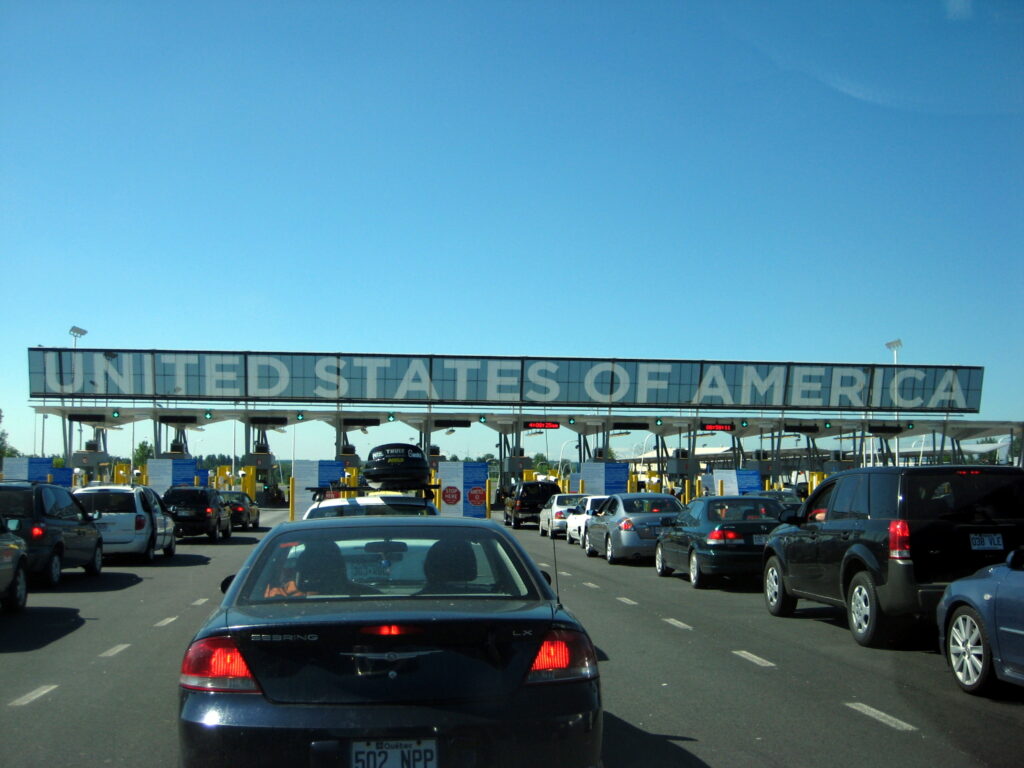The COVID-19 pandemic has created unprecedented travel restrictions around the globe. These restrictions have been issued as a way to try to prevent the wildfire-like spread of the virus in order for global health agencies to have time and resources to help those who are stricken with the virus. Restrictions are in place on a country-wide level as well as a state level with individual countries and states having varied (and changing) rules in place.
For those who travel between locations seasonally, this poses a significant challenge. Each state border crossing could potentially have a required quarantine period before being allowed to proceed. For those traveling between Alaska and the lower 48, there is the daunting task of additionally crossing the US-Canada international border…. Twice.

Plan ahead before crossing the US-Canada border during the COVID-19 pandemic. Photo by bobbsled via Flickr Creative Commons
US Border Checkpoint by bobbsled is licensed under CC BY-SA 2.0
Border crossing during COVID-19
The US State Department issued a Global Health Advisory on March 31, 2020, putting travel by US citizens through Canada at Health Advisory Level 4: Do Not Travel. At that time, the State Department advised US citizens outside of the US to make arrangements to return to the US immediately unless they are prepared to “remain abroad for an indefinite period” and “avoid all international travel.”
What this boils down to is the US government sending a get-home-now-or-we-can’t-help-you-get-home statement. On March 20, 2020, the Canadian Border Services Agency closed the Canadian borders to all non-essential travel, including any travel that could be considered tourism or recreational in nature.
Travelers are advised to expect lengthy delays at ports of entry. When contacted, the Canada Border Services Agency sent a statement that the situation is evolving rapidly and border situations can change at any time.
If you will be traveling through Canada, be advised that you may be required to present documentation of your essential travel, may be required to do a quarantine to enter Canada, and may be turned around and denied entry at the Canadian Border. The US Consulate General in Vancouver suggests checking their website where you can find the most up-to-date information and enroll in the Smart Traveler Enrollment Program (STEP) before you travel to receive alerts and ensure you can be located in an emergency.
Another consideration to keep in mind before you attempt to travel through Canada is that many of the services that cater to travelers (RV parks, restaurants, hotels, etc.) may be closed or restricted. Additionally, the supply chain in more remote areas along the Alaska Highway may be disrupted or delayed at times. Travelers should plan accordingly with extra food, fuel, and repair equipment.
As with any travel, the concentration of people interacting with the facilities that are operating during this time will create a potential virus load on surfaces, which could increase your exposure risk. Using a face covering, meticulous hand washing, avoiding touching your face, and maintaining a minimum of 6 feet distance away from other people should be observed at all times. If possible, try to change clothes (or shed a layer) for riding in your vehicle to keep any outside virus contamination from the space where you will sit for many driving hours.
- You can check current border crossing requirements and cautionary statements crossing INTO Canada at the Canada Border Services Agency website.
- You can check current border crossing requirements and cautionary statements crossing INTO the US at the US Customs and Border Protection website.
If you are traveling between states, please check ahead as to what each state you will be traveling through advises for travelers.

Canada has just tighened up requirements as of April 10th. You now have to fill out a form stating your plans to quarantine yourself for14 days and where. Last time I checked, Canadians are still being allowed into the US from Mexico on the understanding they are transiting as fast as possible to Canada. We crossed couple of RV Caravans from Mexico a week ago. Candians face fines of up to $750,000 for non compliance. Americans have to have a good reason to be allowed in. (EG transit to Alaska)
One could take a boat, Ocean Going Ferry or barge trip from Seattle to Alaska & save on the wear tear on the tires & suspension system on one’s TT & TV. The fuel savings should offset most of the costs. Cdn TT hop on a Ferry when traveling too or from the Province of Newfoundland. My suggestion is not recommended for those who get sea sick. If you have young kids take a camera so you can film – record your better different chases each one from one deck level to another. kids just love to play hide & seek on board a ship.